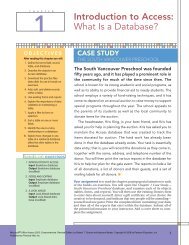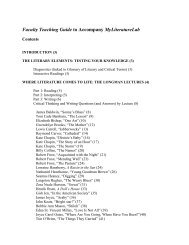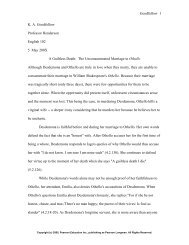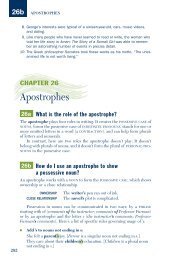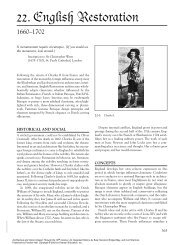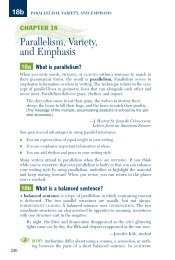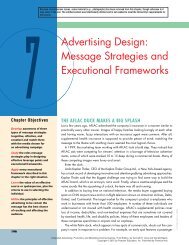chapter 3 - Pearson Learning Solutions
chapter 3 - Pearson Learning Solutions
chapter 3 - Pearson Learning Solutions
Create successful ePaper yourself
Turn your PDF publications into a flip-book with our unique Google optimized e-Paper software.
2009934667<br />
Chapter 3 Nonverbal Communication 73<br />
of the emphasis projected by the advertising industry on attractiveness in their<br />
magazine, newspaper, and television ads.<br />
The attitude toward the way people look carries over into the way people are<br />
evaluated. Attractive people are often given credit—known as the halo effect—for<br />
other qualities such as high intelligence and better job performance. Meanwhile,<br />
unattractive people may be cast by the devil effect—a negative evaluation because<br />
of the way they look, regardless of their intelligence or job performance. 70<br />
Attractiveness is in the eye of the beholder. What it means to be attractive differs<br />
from culture to culture. For example, judges at international beauty contests have<br />
difficulty determining who the winner is because of the vast physical differences<br />
among the contestants and the lack of a universal definition of beauty. And, though<br />
thinness for women might be the “in” beauty criterion in the white European<br />
American culture, that is not necessarily true in African American culture. In a study<br />
of teenage girls, white girls painted attractiveness as “5' 7," between 100 and 110<br />
pounds, with blue eyes and long flowing hair.” 71 However, the black girls in the study<br />
named full hips and large thighs as the signs of attractiveness. 72<br />
It is generally assumed that females are more vain, more concerned about their<br />
physical appearance, and more dissatisfied with their bodies than males are. It is<br />
known for example, that more females than males have eating disorders such as<br />
bulimia and anorexia. However, “It’s not just women who are dissatisfied with their<br />
bodies: men seem to be, too. Men’s dissatisfaction stems primarily from believing<br />
themselves to be less muscular than they really are. Body image is linked to depression,<br />
eating pathology, low self-esteem and using performance-enhancing<br />
substances.” 73<br />
A jury’s decision can be affected by both the plaintiff’s and the defendant’s physical<br />
appearances. In one study, participants in an automobile-negligence trial heard<br />
Attractiveness is in the eye<br />
of the beholder.<br />
Communicating: A Social and Career Focus, Tenth Edition, by Roy M. Berko, Andrew D. Wolvin, and Darlyn R. Wolvin. Published by Allyn & Bacon.<br />
Copyright © 2007 by <strong>Pearson</strong> Education, Inc.






